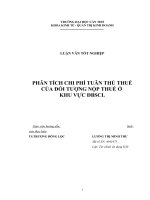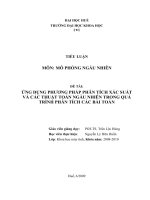Phân tích các bài đọc trong toeic 5 doc
Bạn đang xem bản rút gọn của tài liệu. Xem và tải ngay bản đầy đủ của tài liệu tại đây (64.85 KB, 6 trang )
(D) A good scientist needs to be creative
Questions 11-21
By the mid-nineteenth century, the term "icebox" had entered the American
language, but ice was still only beginning to affect the diet of ordinary citizens in the
United States. The ice trade grew with the growth of cities. Ice was used in hotels,
Line taverns, and hospitals, and by some forward-looking city dealers in fresh meat, fresh
(5) fish, and butter. After the Civil War(1861-1865), as ice was used to refrigerate freight
cars, it also came into household use. Even before 1880, half the ice sold in New York,
Philadelphia, and Baltimore, and one-third of that sold in Boston and Chicago, went to
families for their own use. This had become possible because a new household
convenience, the icebox, a precursor of the modern refrigerator, had been invented.
(10) Making an efficient ice box was not as easy as we might now suppose. In the early
nineteenth century, the knowledge of the physics of heat, which was essential to a
science of refrigeration, was rudimentary. The commonsense notion that the best
icebox was one that prevented the ice from melting was of course mistaken, for it was
the melting of the ice that performed the cooling. Nevertheless, early efforts to
(15) economize ice included wrapping the ice in blankets, which kept the ice from doing its
job. Not until near the end of the nineteenth century did inventors achieve the delicate
balance of insulation and circulation needed for an efficient icebox.
But as early as 1803, an ingenious Maryland farmer, Thomas Moore, had been on
the right track. He owned a farm about twenty miles outside the city of Washington, for
(20) which the village of Georgetown was the market center. When he used an icebox of his
own design to transport his butter to market, he found that customers would pass up the
rapidly melting stuff in the tubs of his competitors to pay a premium price for his
butter, still fresh and hard in neat, one-pound bricks. One advantage of his icebox,
Moore explained, was that farmers would no longer have to travel to market at night in
(25) order to keep their produce cool.
11. What does the passage mainly discuss?
(A) The influence of ice on the diet
(B) The development of refrigeration
(C) The transportation of goods to market
(D) Sources of ice in the nineteenth century
12. According to the passage, when did the word "icebox" become part of
the language of the United States?
(A) In 1803
(B) Sometime before 1850
(C) During the Civil War
(D) Near the end of the nineteenth century
13. The phrase "forward-looking" in line 4 is closest in meaning to
(A) progressive (B) popular
(C) thrifty (D) well-established
14. The author mentions fish in line 5 because
(A) many fish dealers also sold ice
(B) fish was shipped in refrigerated freight cars
(C) fish dealers were among the early commercial users of ice
(D) fish was not part of the ordinary person's diet before the invention
of the icebox
15. The word "it" in line 6 refers to
(A) fresh meat
(B) the Civil War
(C) ice
(D) a refrigerator
16. According to the passage, which of the following was an obstacle to the
development of the icebox?
(A) Competition among the owners of refrigerated freight cars
(B) The lack of a network for the distribution of ice
(C) The use of insufficient insulation
(D) Inadequate understanding of physics
17. The word "rudimentary" in line 12 is closest in meaning to
(A) growing
(B) undeveloped
(C) necessary
(D) uninteresting
18. According to the information in the second paragraph, an ideal
icebox would
(A) completely prevent ice from melting
(B) stop air from circulating
(C) allow ice to melt slowly
(D) use blankets to conserve ice
19. The author describes Thomas Moore as having been "on the right
track" (line18 -19) to indicate that
(A) the road to the market passed close to Moore's farm
(B) Moore was an honest merchant
(C) Moore was a prosperous farmer
(D) Moore's design was fairly successful
20. According to the passage, Moore's icebox allowed him to
(A) charge more for his butter
(B) travel to market at night
(C) manufacture butter more quickly
(D) produce ice all year round
21. The "produce" mentioned in line 25 could include
(A) iceboxes
(B) butter
(C) ice
(D) markets
Questions 22-23
Aside from perpetuating itself, the sole purpose of the American Academy and
Institute of Arts and Letters is to "foster, assist and sustain an interest" in literature,
music, and art. This it does by enthusiastically handing out money. Annual cash awards
Line are given to deserving artists in various categories of creativity: architecture, musical
(5) composition, theater, novels, serious poetry, light verse, painting, sculpture. One award
subsidizes a promising American writer's visit to Rome. There is even an award for a
very good work of fiction that failed commercially ― once won by the young John
Updike for
the Poorhouse Fair and, more recently, by Alice Walker for In Love and
Trouble.
(10) The awards and prizes total about $750,000 a year, but most of them range in size
from $5,000 to $12,500, a welcome sum to many young practitioners whose work may
not bring in that much money in a year. One of the advantages of the awards is that
many go to the struggling artists, rather than to those who are already successful.
Members of the Academy and Institute are not eligible for any cash prizes. Another
(15) advantage is that, unlike the National Endowment for the Arts or similar institutions
throughout the world, there is no government money involved.
Awards are made by committee. Each of the three departments ― Literature
(120 members), Art(83), Music(47) ― has a committee dealing with its own field.
Committee membership rotates every year, so that new voices and opinions are
(20) constantly heard.
The most financially rewarding of all the Academy-Institute awards are the Mildred
and Harold Strauss Livings. Harold Strauss, a devoted editor at Alfred A. Knopf, the
New York publishing house, and Mildred Strauss, his wife, were wealthy and childless.
They left the Academy-Institute a unique bequest : for five consecutive years, two
(25) distinguished (and financially needy) writers would receive enough money so they
could devote themselves entirely to "prose literature"(no plays, no poetry, and no
paying job that might distract). In 1983, the first Strauss Livings of $35,000 a year
went to short-story writer Raymond Carver and novelist-essayist Cynthia Ozick. By
1988, the fund had grown enough so that two winners, novelists Diane Johnson and
(30) Robert Stone, each got $50,000 a year for five years.
22. What does the passage mainly discuss?
(A) Award-winning works of literature
(B) An organization that supports the arts
(C) The life of an artist
(D) Individual patrons of the arts
23. The word "sole" in line 1 is closest in meaning to
(A) only
(B) honorable
(C) common
(D) official
24. The word "subsidizes" in line 6 is closest in meaning to
(A) assures
(B) finances
(C) schedules
(D) publishes
25. Which of the following can be inferred about Alice Walker's book
In Love and Trouble ?
(A) It sold more copies than The Poorhouse Fair.
(B) It described the author's visit to Rome.
(C) It was a commercial success.
(D) It was published after The Poorhouse Fair.
26. Each year the awards and prizes offered by the Academy-Institute
total approximately
(A) $ 12,500
(B) $ 35,000
(C) $ 50,000
(D) $ 750,000
27. The word "may" in line 13 refers to
(A) practitioners
(B) advantages
(C) awards
(D) strugglers
28. What is one of the advantages of the Academy-Institute awards mentioned
in the passage?
(A) They are subsidized by the government.
(B) They are often given to unknown artists.
(C) They are also given to Academy-Institute members.
(D) They influence how the National Endowment for the Arts makes its
award decisions.
29. The word "rotates" in line 19 is closest in meaning to
(A) alternate
(B) participates
(C) decides
(D) meets
30. The word "they" in line 25 refers to
(A) Mildred and Harold Strauss
(B) years
(C) writers
(D) plays
31. Where in the passage does the author cite the goal of the Academy-Institute?
(A) Lines 1-3
(B) Lines 12-13
(C) Lines 19-20
(D) Lines 22-23
Questions 32-42
Archaeological records ― paintings, drawings, and carvings of humans engaged in
activities involving the use of hands ― indicate that humans have been predominantly
right-handed for more than 5,000 years. In ancient Egyptian artwork, for example, the
Line right-hand is depicted as the dominant one in about 90percent of the examples. Fracture
(5) or wear patterns on tools also indicate that a majority of ancient people were
right-handed.
Cro-Magnon cave paintings some 27,000years old commonly show outlines of
human
hands made by placing one hand against the cave wall and applying paint with the
other. Children today make similar outlines of their hands with crayons on paper. With
few exceptions, left hands of Cro-Magnons are displayed on cave walls, indicating that
(10) the paintings were usually done by right-handers.
Anthropological evidence pushes the record of handedness in early human ancestors
back to at least 1.4 million years ago. One important line of evidence comes from
flaking patterns of stone cores used in toolmaking: implements flaked with a
clockwise motion (indicating a right-handed toolmaker) can be distinguished from
(15) those flaked with a counter-clockwise rotation (indicating a left-handed toolmaker).
Even scratches found on fossil human teeth offer clues. Ancient humans are thought
to have cut meat into strips by holding it between their teeth and slicing it with stone
knives, as do the present-day Inuit. Occasionally the knives slip and leave scratches on
the users' teeth. Scratches made with a left-to-right stroke direction (by right-handers)
(20) are more common than scratches in the opposite direction (made by left-handers).
Still other evidence comes from cranial morphology: scientists think that physical
differences between the right and left sides of the interior of the skull indicate subtle
physical differences between the two sides of the brain. The variation between the
hemispheres corresponds to which side of the body is used to perform specific
(25) activities. Such studies, as well as studies of tool use, indicate that right- or left-sided
dominance is not exclusive to modern Homo sapiens. Populations of Neanderthals,
such as Homo erectus and Homo habilis, seem to have been predominantly
right-handed, as we are.
32. What is the main idea of the passage?
(A) Human ancestors became predominantly right-handed when
they began to use tools.
(B) It is difficult to interpret the significance of anthropological evidence
concerning tool use.
(C) Humans and their ancestors have been predominantly right-handed
for over a million years.
(D) Human ancestors were more skilled at using both hands than modern
humans.
33. The word "other" in line 8 refers to
(A) outline (B) hand
(C) wall (D) paint
34. What does the author say about Cro-Magnon paintings of hands?
(A) Some are not very old.
(B) It is unusual to see such paintings.
(C) Many were made by children.
(D) The artists were mostly right-handed.
35. The word "implements" in line 13 is closest in meaning to
(A) tools (B) designs
(C) examples (D) pieces
36. When compared with implements "flaked with a counter-clockwise rotation"
(line15),
it can be inferred that "implements flaked with a clockwise motion" (lines 13-14) are
(A) more common
(B) larger
(C) more sophisticated
(D) older
37. The word "clues" in line 16 is closest in meaning to
(A) solutions
(B) details
(C) damage
(D) information
38. The fact that the Inuit cut meat by holding it between their teeth is significant
because
(A) the relationship between handedness and scratches on fossil human teeth can
be verified
(B) it emphasizes the differences between contemporary humans and their ancestors
(C) the scratch patterns produced by stone knives vary significantly from patterns
produced by modern knives
(D) it demonstrates that ancient humans were not skilled at using tools
39. The word "hemispheres" in line 24 is closest in meaning to
(A) differences (B) sides
(C) activities (D) studies
40. Why does the author mention Homo erectus and Habilis in line 27
(A) To contrast them with modern humans
(B) To explain when human ancestors began to make tools









